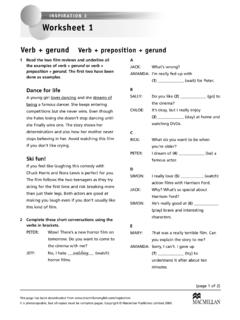Transcription of Edward de Bono’s 6 Thinking Hats
1 Edward de Bono s 6 Thinking hats The notion of six Thinking hats comes from Edward De Bono (Read Six Thinking hats by Edward De Bono, 1985) It is a simple and effective system that increases productivity. There are six metaphorical hats and each defines a certain type of Thinking . You can put on or take off one of these hats to indicate the type of Thinking you are using. This putting on and taking off is essential, because it allows you to switch from one type of Thinking to another. When done in a group, everybody should wear the same hat at the same time. The principle behind the 'Six Thinking hats ' is parallel Thinking which ensures that all the people in a meeting are focused on and Thinking about the same subject at the same time. In this system, Thinking is divided into six categories with each category identified with its own coloured metaphorical ' Thinking hat'.
2 Organisations that use the 'Six Thinking hats ' system report that their teams are more productive and in general "happier and healthier". The Six hats : The White Hat: calls for information known or needed. "The facts, just the facts." The Yellow Hat: symbolizes brightness and optimism. You can explore the positives and probe for value and benefit The Black Hat: signifies caution and critical Thinking - do not overuse! Why something may not work The Green Hat: focuses on creativity, possibilities, alternatives and new ideas. It is an opportunity to express new concepts and new perceptions - lateral Thinking could be used here The Blue Hat: is used to manage the Thinking process. It ensures that the 'Six Thinking hats ' guidelines are observed. The Red Hat: signifies feelings, hunches and intuition - the place where emotions are placed without explanation Sheets produced by Paul Foreman at Edward de Bono s 6 Thinking hats The white hat Calls for information known or needed gathering just the facts The white hat covers facts, figures, data and information.
3 Too often facts and figures are embedded in an argument or belief. Wearing your white hat allows you to present information in a neutral and objective way. Questions you might ask while wearing your white hat include: What information do we have here? What information is missing? What information would we like to have? How are we going to get the information? When you put on your white hat, you focus directly on the information what is available, what is needed, and how it might be obtained. Proposals, opinions, beliefs and arguments should be put aside. The Six hats : The White Hat: calls for information known or needed. "The facts, just the facts." The Yellow Hat: symbolizes brightness and optimism. You can explore the positives and probe for value and benefit The Black Hat: signifies caution and critical Thinking - do not overuse!
4 Why something may not work The Green Hat: focuses on creativity, possibilities, alternatives and new ideas. It is an opportunity to express new concepts and new perceptions - lateral Thinking could be used here The Blue Hat: is used to manage the Thinking process. It ensures that the 'Six Thinking hats ' guidelines are observed. The Red Hat: signifies feelings, hunches and intuition - the place where emotions are placed without explanation Sheets produced by Paul Foreman at Edward de Bono s 6 Thinking hats The yellow hat Calls for optimism, positive aspects The yellow hat is for optimism and the logical positive view of things. Wearing the yellow hat allows you to look for benefits, feasibility and how something can be done. Questions you might ask while wearing the yellow hat include: What are the benefits of this option?
5 Why is this proposal preferable? What are the positive assets of this design? How can we make this work? Yellow hat Thinking is a deliberate search for the positive. Benefits are not always immediately obvious and you might have to search for them. Every creative idea deserves some yellow hat attention. The Six hats : The White Hat: calls for information known or needed. "The facts, just the facts." The Yellow Hat: symbolizes brightness and optimism. You can explore the positives and probe for value and benefit The Black Hat: signifies caution and critical Thinking - do not overuse! Why something may not work The Green Hat: focuses on creativity, possibilities, alternatives and new ideas. It is an opportunity to express new concepts and new perceptions - lateral Thinking could be used here The Blue Hat: is used to manage the Thinking process.
6 It ensures that the 'Six Thinking hats ' guidelines are observed. The Red Hat: signifies feelings, hunches and intuition - the place where emotions are placed without explanation Sheets produced by Paul Foreman at Edward de Bono s 6 Thinking hats The black hat Judgment, caution and evaluation Wearing the black hat allows you to consider your proposals critically and logically. The black hat is used to reflect on why a suggestion does not fit the facts, the available experience, or the system in use. Wearing your black hat you might consider the following: Costs. (This proposal would be too expensive.) Regulations. (I don't think that the regulations would allow .. ) Design. (This design might look nice, but it is not practical.) Materials. (This material would mean high maintenance.) Safety issues.
7 (What about handrails?) Mistakes can be disastrous. So the black hat is very valuable. It is the most used hat and possibly the most useful hat. However, it is very easy to overuse the black hat. Caution, used too early in the problem solving process, can easily kill creative ideas with early negativity. The Six hats : The White Hat: calls for information known or needed. "The facts, just the facts." The Yellow Hat: symbolizes brightness and optimism. You can explore the positives and probe for value and benefit The Black Hat: signifies caution and critical Thinking - do not overuse! Why something may not work The Green Hat: focuses on creativity, possibilities, alternatives and new ideas. It is an opportunity to express new concepts and new perceptions - lateral Thinking could be used here The Blue Hat: is used to manage the Thinking process.
8 It ensures that the 'Six Thinking hats ' guidelines are observed. The Red Hat: signifies feelings, hunches and intuition - the place where emotions are placed without explanation Sheets produced by Paul Foreman at Edward de Bono s 6 Thinking hats The red hat The red hat covers intuition, feelings, hunches and emotions. Usually, feelings and intuition can only be introduced into a discussion if they are supported by logic. Often, the feeling is genuine but the logic is spurious. Wearing the red hat allows you to put forward your feelings and intuitions without the need for justification, explanation or apology. Putting on the red hat, you express what you feel about the project. Examples: My gut-feeling is that this will not work. I don't like the way this is being done. This proposal is terrible. My intuition tells me that prices will fall soon.
9 The red hat allows feelings to come into the discussion without pretending to be anything else. It is always valuable to get feelings out into the open. The Six hats : The White Hat: calls for information known or needed. "The facts, just the facts." The Yellow Hat: symbolizes brightness and optimism. You can explore the positives and probe for value and benefit The Black Hat: signifies caution and critical Thinking - do not overuse! Why something may not work The Green Hat: focuses on creativity, possibilities, alternatives and new ideas. It is an opportunity to express new concepts and new perceptions - lateral Thinking could be used here The Blue Hat: is used to manage the Thinking process. It ensures that the 'Six Thinking hats ' guidelines are observed. The Red Hat: signifies feelings, hunches and intuition - the place where emotions are placed without explanation Sheets produced by Paul Foreman at Edward de Bono s 6 Thinking hats The green hat The green hat is specifically concerned with creating new ideas and new ways of looking at things: creative Thinking Additional alternatives putting forward possibilities and hypotheses interesting proposals new approaches provocations and changes The green hat makes time and space available to focus on creative Thinking .
10 Even if no creative ideas are forthcoming, the green hat asks for the creative effort. Often green hat Thinking is difficult because it goes against our habits of recognition, judgment and criticism. Typical questions include: Are there any other ideas here? Are there any additional alternatives? Could we do this in a different way? Could there be another explanation? The Six hats : The White Hat: calls for information known or needed. "The facts, just the facts." The Yellow Hat: symbolizes brightness and optimism. You can explore the positives and probe for value and benefit The Black Hat: signifies caution and critical Thinking - do not overuse! Why something may not work The Green Hat: focuses on creativity, possibilities, alternatives and new ideas. It is an opportunity to express new concepts and new perceptions - lateral Thinking could be used here The Blue Hat: is used to manage the Thinking process.








